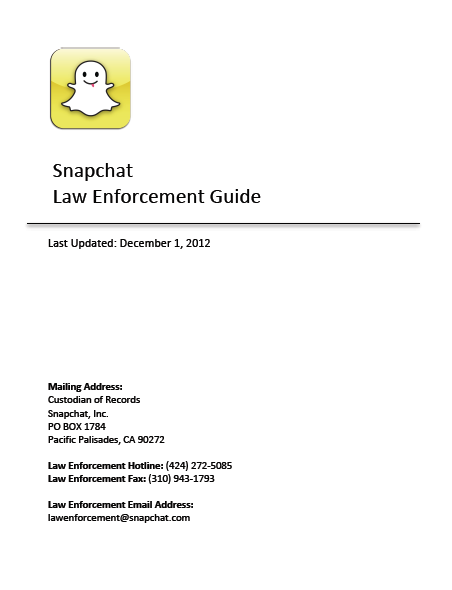I. Snap and Law Enforcement Overview
Snapchat is a mobile application made by Snap Inc. (“Snap”) and available through the iPhone App Store and Google Play Store. The Snapchat app provides users a way to share moments with photos, videos, and chats.
This guide provides information for law enforcement officials seeking records from Snap.
U.S. Legal Process Requirements
Snap discloses account records solely in accordance with our Terms of Service, the Stored Communications Act, 18 U.S.C. §2701, et seq. (“SCA”), and other applicable laws. The SCA mandates that we disclose certain user data to law enforcement only in response to specific types of legal process, including subpoenas, court orders, and search warrants. Generally, the SCA authorizes law enforcement to compel us to disclose basic subscriber information, non-content account information, and account content (as described in Section V “Required Legal Process” below) in response to appropriate legal process.
International Legal Process Requirements
Non-U.S. governmental and law enforcement agencies must rely on the mechanics of the Mutual Legal Assistance Treaty (“MLAT”) or letters rogatory processes to seek user information from Snap. As a courtesy to international law enforcement, we will review and respond to properly submitted preservation requests (see Section VI “Preservation Requests” below) while the MLAT or letters rogatory process is undertaken.
Snap may, at its discretion, provide limited user account information to government agencies outside of the U.S. on an emergency basis when we believe that doing so is necessary to prevent death or serious physical harm to someone.
…
III. How Snapchat Works
The following is an overview of how the Snapchat app works. Additional information is available on the Snapchat Support Site at https://support.snapchat.com.
Snaps
Snaps are photos or videos taken using the Snapchat app’s camera on an individual’s mobile device, and may be shared directly with the user’s friends, or in a Story (explained below) or Chat.
Snap’s servers are designed to automatically delete a Snap after it has been viewed by all intended recipients. Snap’s servers are designed to automatically delete an unopened Snap sent directly to a recipient after 30 days and an unopened Snap in Group Chat after 24 hours.
Stories
A user can add Snaps to their “Story”. A Story is a collection of Snaps displayed in chronological order. Users can manage their privacy settings so that their Story can be viewed by all Snapchatters, their friends, or a custom audience. A user can also submit their Snaps to our crowd-sourced service “Our Story”, which enables their Snaps to be viewed by all Snapchatters in Search and Snap Map.
Snap’s servers are designed to automatically delete a Snap in a user’s Story 24 hours after the user posts the Snap, but the user may delete part or all of the Story earlier. Submissions to Our Story may be saved for longer periods of time.
Memories
Memories is Snapchat’s cloud-storage service. Users can save their sent or unsent Snaps, posted Stories, and photos and videos from their phone’s photo gallery in Memories. Content saved in Memories is backed up by Snap and may remain in Memories until deleted by the user. Users may encrypt their content in Memories (called “My Eyes Only”), in which case the content is not accessible to Snap and cannot be decrypted by Snap.
Chat
A user can type messages, send Snaps, audio notes, and video notes to friends within the Snapchat app using the Chat feature. Our servers are designed to automatically delete one-to-one chats once the recipient has opened the message and both the sender and recipient have left the chat screen, depending on the user’s chat settings.
Snap’s servers are designed to automatically delete unopened one-to-one chats in 30 days. Users can also chat in groups. Chats sent in groups are deleted after 24 hours whether they are opened or not. A user can save a message in Chat by pressing and holding the message. The user can unsave the message by pressing and holding it again. This will delete it from our servers. Users can also delete chats that they have sent to a recipient before the recipient has opened the chat or after the recipient has saved the chat.
Location Data
If a user has device-level location services turned on and has opted into location services on Snapchat, Snap will collect location data at various points during the user’s use of Snapchat, and retention periods for location data vary depending on the purpose of the collection. Users have some control over the deletion of their location data in the app settings.

